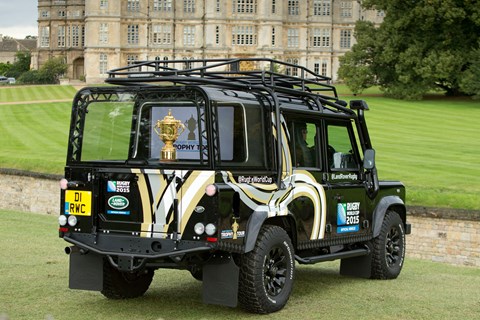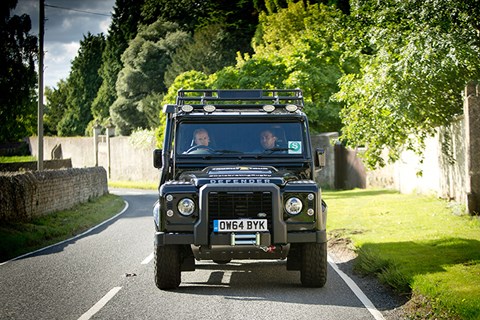► Drive of £150,000, one-off Rugby World Cup Defender
► Built by Land Rover’s Special Operations division
► World cup winner Jason Robinson in the passenger seat
► Webb Ellis trophy housed in special rear compartment
Jason Robinson, the rugby star who played in three World Cup finals, is talking to me about pressure. ‘Can England handle the pressure? If they get a poor result, can they turn it around within the space of seven days? That’s one of the key things.’ His words are heavy with meaning, given England will be out of their home World Cup if they lose again tonight, in their showdown with Australia.
So there’s the pressure Jason was under in 2003, walking out to face Australia in the Rugby World Cup final. Then there’s the pressure the England rugby union team will feel at Twickenham tonight, having lost to Wales last week. And there’s the pressure I’m currently under: trying to slot the Rugby World Defender into first, with a gearstick as long as a walking cane, and a clutch so exercising it’ll turn my pipecleaner legs into a prop forward’s tree trunks.
This is definitely one of the more absurd drives of my career: to chauffeur Jason from a Peterborough hotel to the Burghley Horse Trials, 13 miles away. We’re in a 110 Station Wagon, but one with a difference: the rear has been converted into an air-conditioned trophy cabinet, housing the Webb Ellis Cup behind special security glass. The conversion (geddit!) took 6000 hours to design and build, by Jaguar Land Rover’s Special Operations team.

The cost of this one-off Defender? £150,000. And it’s carrying a golden cargo of the World Cup trophy, and probably England’s most successful rugby player in history – with me at the wheel. Specialist car insurers Adrian Flux reckon the Land Rover alone would command a £1750 annual premium, five times a typical Landie’s, and that’s before you factor in the value of the load. Gulp.
You practically need a lineout lift to propel you up and into the lofty cockpit. It’s so narrow I’m thankful this Land Rover ambassador is a former winger, rather than having a giant forward like Martin Johnson spilling out of the black leather and gold-stitched passenger seat and onto me. The 2.2-litre Transit diesel engine is chugging away, so I let out the monstrously heavy clutch and we set sail left out of the car park. Except we veer off to the right: I’d forgotten how slow the Defender is around the tiller, and how much lock you need to perform the gentlest of turns.
To try to distract Jason from my imprecise first manoeuvre, I express my fears about England’s group of death: only two of England, Wales and Australia can go through to the quarter finals (with apologies to group makeweights Fiji and Uruguay). ‘It’s going to be tough,’ he agrees. ‘They have to believe they can win: within the group of players, it’s them against the world. They’ll be so focused on the job in hand. They’ve got to go out and man-for-man do themselves proud, take hold of the opportunity, and then the team will do themselves proud. To be the best you’ve got to beat the best.’
By now we’re out on the open road. Land Rover suggested I take a picturesque route to Stamford, and although we’re rolling through rural Cambridgeshire, the Defender is not in its element on fast A-road sweepers. The live axles skip over bumps, and the body rolls exaggeratedly in corners: thankfully the cup is held in place by a magnetic cam that clamps to the trophy’s base.
Jason’s reminiscences of England’s 2007 campaign provide encouragement. ‘We were awful [initially],’ he recalls bluntly in his soft Yorkshire accent. ‘But somehow we raised our game when it mattered. The shame of losing 36-0 to South Africa in the group: it was so embarrassing, you can’t wait to get back on the field and put that right. Form can just come. On the day, everybody knows you can beat the opposition – if you make it your day, don’t make mistakes, and you’re on fire man-for-man.’

The Defender is chuntering along at 50mph, engine growling, tyres roaring, wind whistling. It’s taken a while to build up the speed, given 0-62mph takes the best part of 15secs. Jason is used to plusher JLR cars: he’s got an F-type R coupe and a Range Rover Sport supercharged V8, which he hopes to upgrade to the SVR flagship next. Appropriate performance for a player nicknamed Billy Whizz for his speedy attacks. And a far cry from Jason’s first car, a Maxi 1750, which he bought with a mate for £25 each.
So what made England World Cup winners in 2003? ‘We had a great team, guys like Martin Johnson, Lawrence Dallaglio, Jason Leonard, Jonny Wilkinson, and a great coach in Sir Clive Woodward. We’d been together, knew each other inside out, been through key experiences, some heavy defeats. There was never a moment during that World Cup that I didn’t think we could win it, and the other guys thought the same.
‘We’d worked so hard, covered every different scenario, training was repetition after repetition, and we had great coaches. We even had an eye coach to help us see the spaces, be aware of what was around us, improve hand:eye co-ordination and using our peripheral vision. It matters because sometimes one call can win or lose you a game. We made sure that if we didn’t win that World Cup it wasn’t due to our preparation, it was because we weren’t good enough.’ Amen to that.
Finally we arrive at our destination. Jason is tackled by TV presenter Clare Balding, eager for an interview, and fans swarm around the Defender, folding down its ‘selfie seat’ and perching to have their picture taken in front of the trophy. It’s not quite 80 minutes of do or die World Cup rugby, but the physical Defender has given me a decent work out, and it’s a satisfying result. Pressure? What pressure…?
Click here to read CAR’s review of the regular Land Rover Defender 110 Station Wagon – this time without any priceless trophies on board.